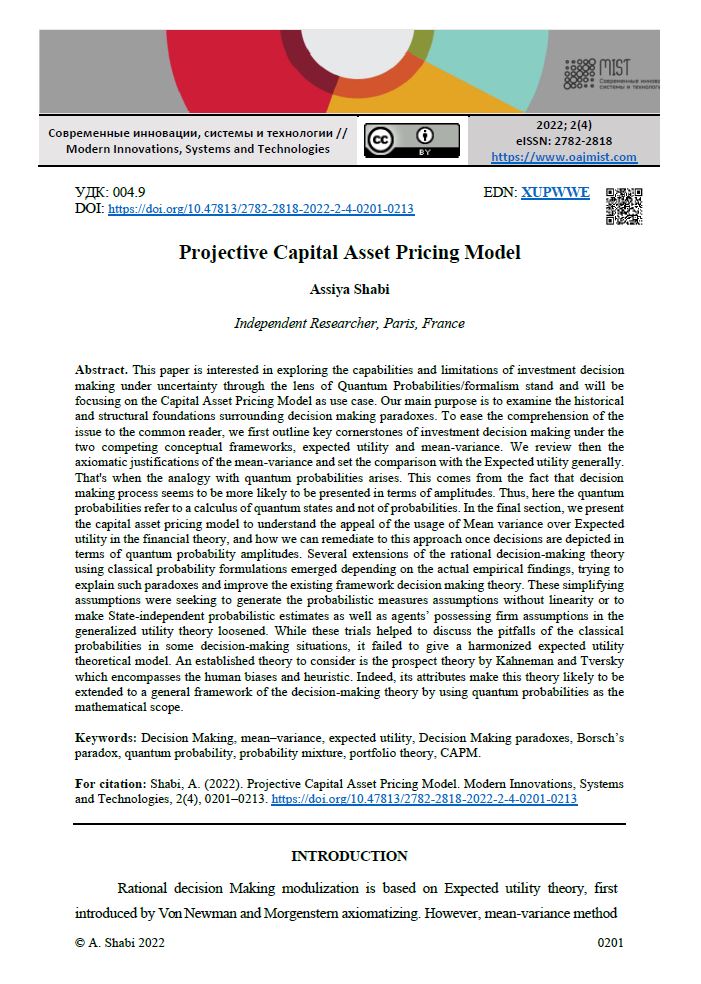Projective Capital Asset Pricing Model
DOI:
https://doi.org/10.47813/2782-2818-2022-2-4-0201-0213Ключевые слова:
Decision Making, mean–variance, expected utility, Decision Making paradoxes, Borsch’s paradox, quantum probability, probability mixture, portfolio theory, CAPM.Аннотация
This paper is interested in exploring the capabilities and limitations of investment decision making under uncertainty through the lens of Quantum Probabilities/formalism stand and will be focusing on the Capital Asset Pricing Model as use case. Our main purpose is to examine the historical and structural foundations surrounding decision making paradoxes. To ease the comprehension of the issue to the common reader, we first outline key cornerstones of investment decision making under the two competing conceptual frameworks, expected utility and mean-variance. We review then the axiomatic justifications of the mean-variance and set the comparison with the Expected utility generally. That's when the analogy with quantum probabilities arises. This comes from the fact that decision making process seems to be more likely to be presented in terms of amplitudes. Thus, here the quantum probabilities refer to a calculus of quantum states and not of probabilities. In the final section, we present the capital asset pricing model to understand the appeal of the usage of Mean variance over Expected utility in the financial theory, and how we can remediate to this approach once decisions are depicted in terms of quantum probability amplitudes. Several extensions of the rational decision-making theory using classical probability formulations emerged depending on the actual empirical findings, trying to explain such paradoxes and improve the existing framework decision making theory. These simplifying assumptions were seeking to generate the probabilistic measures assumptions without linearity or to make State-independent probabilistic estimates as well as agents’ possessing firm assumptions in the generalized utility theory loosened. While these trials helped to discuss the pitfalls of the classical probabilities in some decision-making situations, it failed to give a harmonized expected utility theoretical model. An established theory to consider is the prospect theory by Kahneman and Tversky which encompasses the human biases and heuristic. Indeed, its attributes make this theory likely to be extended to a general framework of the decision-making theory by using quantum probabilities as the mathematical scope.
Библиографические ссылки
Aerts, D. Quantum structure in Cognition, Journal of Mathematical Psychology 53(5), pp.314-348, 2009
Allais, M. 1953. Le Comportement de l’Homme Rationneldevant le Risque : Critique des postulats et axiomes del’ ́Ecole Americaine.Econometrica 21: 503-546.
Bitbol, M. Mécanique quantique : Une introduction philosophique, Flammarion 2008.
Johnstone, D. J. and Lindley, D. V. (2011). Elementary proof that mean–variance implies quadratic utility. Theory and Decision 70 149–155
Khrennikov, A. and Haven, E. Quantum social science, Cambridge University Press, 2015.
La Mura, Pierfransesco (2008). Projective expected utility. Journal of Mathematical psychology.
Liu, L. (2004). A new foundation for the mean–variance analysis. European J. Oper. Res.158 229–242.
Luenberger, D.G. Journal of Optimization Theory and Applications (2001) 109: 1.
Levy, H. (2012). The Capital Asset Pricing Model in the21st Century: Analytical, Empirical, and Behavioral Perspectives. Cambridge Univ. Press, Cambridge.
MacLean, L. C., Ziemba, W. T. and Li, Y. (2005). Time to wealth goals in capital accumulation. Quant. Finance 5 343–355.
Pennacchi, G. (2008). Theory of Asset Pricing. Pearson, Boston
Yungnickel I.L., Peter E.D., Polgar A., Weiss E.T. Organic Analysis. New York, 2022. Vol. 1. 127 p.
Gerasimenko A.A., Tihonovich A.V., Shulgin V.I. A Combined approach to determination of power losses in distribution networks. Electrical engineering, electric power engineering and electrotechnologies, proceedings of the II International Conference. Toulouse, 2020, 1, 80-84.

Загрузки
Опубликован
Как цитировать
Выпуск
Раздел
Лицензия
Copyright (c) 2022 Assiya Shabi

Это произведение доступно по лицензии Creative Commons «Attribution» («Атрибуция») 4.0 Всемирная.
Журнал MIST - «Modern Innovations, Systems and Technologies» / «Современные инновации, системы и технологии» публикует материалы на условиях лицензии CreativeCommons Attribution 4.0 International (CC BY 4.0), размещенной на официальном сайте некоммерческой корпорации Creative Commons: 
This work is licensed under a Creative Commons Attribution 4.0 International License.
Это означает, что пользователи могут копировать и распространять материалы на любом носителе и в любом формате, адаптировать и преобразовывать тексты, использовать контент для любых целей, в том числе коммерческих. При этом должны соблюдаться условия использования — указание автора оригинального произведения и источника: следует указывать выходные данные статей, предоставлять ссылку на источник, а также указывать, какие изменения были внесены.























